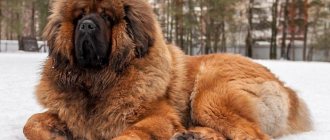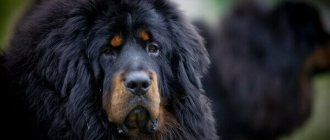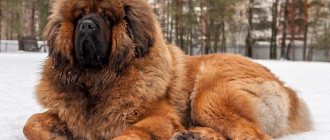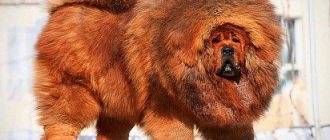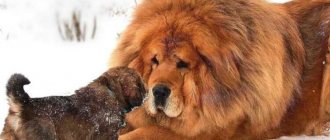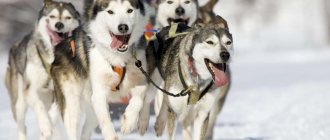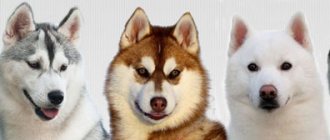Not many people know about this breed of dog, the Tibetan Mastiff. Indeed, today it is quite rare. This breed belongs to the group of Swiss mountain and cattle dogs, Molossers, Pinschers and Schnauzers. What was the Tibetan Mastiff originally bred for? This breed is the most ancient working breed. Dogs belonging to it were used in Tibetan monasteries as guard dogs, and nomads, whose habitat was the Himalayas, valued them as their faithful helpers.
Origin story
You can understand where the Tibetan mastiff comes from from its name. The natural conditions of the mountains are known to be quite harsh. Because of this, Tibetan Mastiffs had to become strong and resilient in order to successfully adapt to their environment. In the mountains they were not influenced by the outside world, thanks to which the breed retained its purity and its strong qualities.
The first mentions of Tibetan mastiffs date back to ancient times. Aristotle had a chance to meet these dogs when he traveled through Asia. Mastiffs and Marco Polos have been noted. These researchers described the breed in their writings, praising the animals' fortitude and endurance. Other travelers also admired the Tibetan mastiffs. There is an assumption that it was from this breed that the Molosser group was subsequently formed.
Despite its ancient origins, the mastiff appeared in Europe only in the 19th century. The dog was presented as a gift to the Queen of England. Somewhat later, Edward VII brought two more such dogs from his trip to Asia. In 1898, the first litter of Tibetan mastiffs appeared in the Berlin Zoo in Europe.
Doors and steps in a dog's life
Living with a dominant dog requires a large number of subtleties that are necessary for the dog to understand that you are its owner, the leader in its life, the person it respects.
One of those little things you should always do is make sure your dog always has to let you through the doorway first and down the flight of stairs behind you.
This may seem like a small thing, but it really isn't.
If you get your dog to do little things like these (which require no struggle at all to achieve), you've already set a certain tone for your relationship.
Interesting Facts
The Tibetan Mastiff is without a doubt one of the largest dogs. However, there is evidence that in former times the size of some individuals of this breed was comparable to that of a donkey.
These dogs are considered the most expensive on our planet. Thus, in 2009, the price for a Tibetan Mastiff puppy was set at 600 thousand dollars (a little more than 40.6 million rubles), and relatively recently one Chinese billionaire paid 10 million yuan for a young dog of this breed. This amount is 1.5 million dollars, or 101 million 536 thousand rubles.
There is a legend according to which the owner of such a dog was Buddha himself.
The Tibetan mastiff is so strong that there are cases when he won fights between wolves and snow leopards.
Having long and lush hair, the dog sleeps peacefully in the snow. She can also spend a long time in bad weather or on ice.
The Mastiff is considered an excellent watchdog. In former times, these dogs were kept on a leash during the day and released at night to protect the territory from enemies and predators. This way of life is not alien to Tibetans even in modern times. They have not lost the habit of dozing during the day and being active at night.
Alpha role and stuff
If I tried to use the Alpha role on one of my adult dogs without a muzzle on, he would "eat my lunch."
When I hear people talk about establishing Alpha leadership over an adult dog, I just shake my head and compare it to Russian Roulette.
For those who don't know what an Alpha role is, let me explain.
When a dog begins to show signs of dominance, many trainers will tell novice owners to force the dog to lie on the ground, belly up, while the owner should lean over the dog, grab it by both cheeks, and look it straight in the eyes until it submits and will look away.
Yes, all this is good for some little Fifi - but better not try this with a big dog who is also really dominant.
I just recently received an e-mail from a friend who told me about an incident they had at a Schutzhund club in California where two dogs started fighting. After the fight was broken up, the owner (who was not very big) tried to apply the Alpha role to her large male German Shepherd (who was not obedience trained in the first year, as she had once heard that it was wrong to train obedience too early). obedience of protection dogs).
As a result, the dog attacked her and inflicted severe bites on her face and upper body, leaving terrible, ugly scars.
The dog was subsequently euthanized.
The most unpleasant thing is that if control over the dog had been established differently, nothing would have happened to this unfortunate woman and the dog would most likely still be alive.
I'm not a fan of the Alpha role. I may be wrong about this.
But I will say that if someone is trying to establish an Alpha role over a large dog, it would be better to muzzle the dog and be big and strong enough to win the fight.
Always remember that if you are going to get into a fight with a dominant dog, it is best to only do so when you are confident that you can win.
My opinion is that in most cases, with very strong, stubborn dominant dogs, it is best to use subtle body language and verbal commands as much as possible. In other words, rather than create situations where I would be forced to take the dog on a leash (and ruin the good relationship between us), I would simply avoid such situations, or simply scold the dog in a stern voice and rise above him.
Sometimes it is possible to "kick the butt" of a dominant dog without even resorting to force in such situations, since direct dominance can provoke an attack. I establish an Alpha position by scolding the dog, or leading him away, or calling him next to him and moving away from the situation.
Breed standard
The Tibetan Mastiff's coat is thick and smooth. This is why animals can be kept outdoors all year round without any problems.
An adult Tibetan mastiff reaches a weight of 60-80 kg. At the same time, the height at the withers of the dog is 60-77 cm. The upper limits of these indicators remain open for the Tibetan mastiff. The main thing for the breed is maintaining the required proportions.
Head
What makes the Tibetan Mastiff different? Strong, voluminous and heavy head. An adult Tibetan Mastiff may have folds between the corners of the mouth and the eyes.
The massive skull of individuals of this breed is rounded at the top and square at the bottom. The bump on the back of the head, as well as the transition from the muzzle to the forehead, are clearly visible in these dogs. What proportions should the individuals have? Compliance with the breed standard is the distance from the occipital protuberance to the transition of the muzzle to the area of the forehead called the stop. It should be equal to the distance from the same stop to the nose. In some cases it is acceptable for the muzzle to be slightly smaller.
As for the jaws, ideally they have a straight or scissor bite. A purebred dog's teeth are always complete and tightly set. The lower jaw is closed with pronounced lips.
The Tibetan Mastiff's eyes are wide apart. According to the breed standard, they should be medium in size, oval in shape and slightly sloping. Tibetans have a proud and impressive expression in their eyes. The eyelids cover the eyeballs quite tightly.
The dog has hanging triangular ears. They are located at the level between the skull and eyes. The ears are covered with soft short hairs and are of medium size; they are slightly tilted forward and slightly raised if the dog is in an excited state.
The neck of the Tibetan Mastiff is quite powerful, with well-developed muscles. It has the shape of an arc with a small dewlap (skin folds).
Lunch time
A dog with a dominance problem should never be allowed in the kitchen or dining room while the family is eating dinner.
The worst thing you can do is feed a dominant dog from the table.
In addition, the leader of the pack always eats first and takes the best pieces of food for himself.
If your dog lives indoors, always lock him in a crate or other room during your lunchtime.
Feeding from the table is the worst thing you can do. This will only increase your problems.
Frame
The Tibetan Mastiff is distinguished by a muscular back and a straight line of the spine. The body of a dog of this breed has a rather voluminous, flat-shaped croup. The chest, reaching the elbow joints, is of medium volume. The ribs when curved resemble the shape of a heart. The breed standard contains the proportions of the ratio of the length of the body of an individual to its height. The first parameter should be slightly larger than the second.
The tail of the Tibetan Mastiff has a high set and medium length. It is located at the level of the spine line. If the dog is alert or excited, it raises its tail and easily throws it over its back.
Bedroom
Controlling dominance starts at home.
The first thing we must do is take control of the places where the dog is allowed to eat, sleep and play.
A dominant dog should never be allowed to sleep on the bed.
The best sleeping place is always reserved for the leader of the pack (you).
Let your dog sleep in a dog crate in another room of the house.
Of course, if the dog lives in a kennel away from home, the advice is not suitable.
Wool
The quality of the Tibetan Mastiff's coat is much more important than its quantity. Moreover, females generally have fewer hairs, while males have more. The coat of purebred Tibetan mastiffs should not have waves or curls, and should also be soft and silky to the touch.
A distinctive feature of the breed is its luxurious mane. It looks like a lion's and covers the shoulders and neck of the dog. In the upper part of the hind legs, the covering looks like a kind of pants.
Toys
While the puppy is growing, he should not be allowed to become the owner of toys.
The owner must be able to take away any toy from the dog at any time, and the dog must not show aggression.
If the puppy growls, the owner should shake him firmly by the scruff of the neck while scolding him.
If the dog is older and can bite, you need to fasten the leash and adjust (make a series of sharp jerks) the leash near the toy.
If at this moment the dog is still growling, it must be scolded in a stern, low voice.
As soon as the dog throws the toy, the owner must take him away before picking up the toy.
Until the dominance situation is under control, this toy should not be given to the dog again.
Only the owner controls the dog's world, and the dog must understand this.
One of the points in this scenario is: “You determine which toys to play with and for how long.”
If the dog does not give up the toy even after correction with the leash, and the owner is not confident that he can safely remove the toy from the dog’s mouth, there are two options for further action:
* Ignore the situation - only enter the fight when you can win.
When your dog finally releases the toy, pick it up and put it away for good. The dog should never play with this toy again.
* If you decide to force the result and win the war for a toy against a strong dog, you need to do some preliminary preparation. First, place the second prong collar on your dog.
Secondly, tie the leash to a solid, strong object - a “post” (that will not move).
When the dog takes the toy, lead him by the leash to the second leash, which is attached to the post.
Attach the second leash to the second collar on the dog.
Now the dog is wearing two leashes, each of which is attached to its own strict collar.
Now tell the dog to drop the toy and, moving away, pull so that the dog is between the post and you.
Apply enough force to make the dog spit out the toy.
Once she does this, praise her.
If you can approach without fear of being bitten, approach and praise your dog soothingly.
If she tries to grab the toy again when you approach, don't freak out, just move back and pull again.
On the part of the owner, this process should not be somehow wild or overly feverish.
Control yourself and remain calm.
Continue pulling as long as your dog continues to try to get the toy back when you approach.
If you don't feel brave enough to pick up the toy, simply kick it away so your dog can't reach it.
Always remember that you should only get involved in a fight if you can win it.
This procedure is only necessary for large dogs.
A small dog just needs to be lifted off the ground and kept in that suspended state until it releases the toy.
This may seem terrible to some soft-hearted owners, but it is no more terrible than a dog biting a child on the face.
Unless you plan to train your dog to be a protective dog, playing tug of war with your puppy is not a good idea.
This develops a sense of ownership in the dog towards its toys.
If you are planning on sport training your Schutzhund or making your dog a bodyguard or police dog, you will be playing a lot of tug of war with your puppy.
It is necessary to develop a sense of ownership first towards the rag, and then towards the sleeve or training costume.
The best Afghan Hound breed description, character, photo, health and care
What needs to be done early in life is to develop the bond that after a dog is allowed to win a game of tug of war a few times, the owner can take that object away from the dog.
I've found that giving your puppy a piece of a treat after you've taken the tugging object is the best way to reward him for giving it up.
This is also the beginning of teaching your dog the “give” command.
On my last trip to Holland I saw my Dutch friend handling his over-dominant KNPV (Royal Dutch Police Dog) police dog.
This dog passed through the hands of many handlers before he came to my friend Jupe.
The dog bit all its owners, including Jupa, until he figured out how to treat this dog.
Now, when they are doing protective work and Jupe commands the dog “give”, he feeds the dog a piece of meat.
Many serious trainers may turn their noses up at this method, but I would suggest that they volunteer to handle this dog in a different way.
To sum it up, we can say that we must think and do exactly what can show the dog who is the leader here.
Color
Tibetan Mastiffs can be:
- black;
- black and tan;
- blue;
- blue and tan;
- golden with a tone from fawn to rich red;
- sable
Tan marks can be of various shades - from red to dark brown. Depending on the coat, the dog's eyes have a brown tint. The standard says that the darkest eye color is the most preferred. Mastiffs should also have black lips and noses.
Mastiff Health and Diseases
Outwardly, the dog looks beautiful, strong, and confident. It seems to ordinary people that such a breed cannot have any problems. This is a misconception. Like all dogs, mastiffs have general and specific diseases.
- Frequency of birth defects, hereditary diseases resulting from inbreeding (hip dysplasia, hock dysplasia, strabismus, different colors of the iris).
- Weakness of the ligamentous apparatus caused by a large load of body weight. It is especially important to remember this during the active growth of the puppy.
- Due to the specific structure of the skull, the mastiff often has eye diseases associated with inflammation of the conjunctiva and mucous membranes.
- Stretching and many folds are a source of problems with the skin. Hair mites are common and microbes multiply.
One sign of a health problem is dull fur. For a smooth-haired dog, it should fit tightly, shimmer in the sun, and be bright. A dog with long hair should be regularly examined for hair mats. Pay special attention to this during shedding, when the undercoat changes.
The biggest problem with a large dog is obesity. It leads to a gain of fat mass, which quickly replaces muscles, and the functioning of the pancreas and liver is disrupted. As a result, intractable diseases such as diabetes mellitus, pancreatitis, ascites, and cholecystitis arise. The owner is forced to completely review the diet, measure blood sugar levels, and monitor stool.
Another problem is ear mites. The structure of the ear shell, its V-shape, helps create favorable conditions for the parasite.
The average life expectancy is relatively short. No more than 8-10 years. Thanks to careful attention, some live up to 15-17 years.
Breed Features
Due to the fact that Tibetan mastiffs were kept in only one closed area for many centuries, the breed remained strong and healthy. Adults practically do not get sick.
The optimal conditions for keeping a Tibetan mastiff are outdoors. Dogs feel better in a backyard. Of course, apartment owners can also get such a breed, but it will be much more difficult. The Mastiff will require long walks to satisfy its exercise needs, as well as more careful training.
In addition, in a city environment, the dog will have to adapt to a variety of smells and sounds, to the noise of the streets, to people with children passing by, to loud groups of teenagers and to other animals. In addition, the fur of an individual living in an apartment will not be as luxurious and thick as that of mastiffs who are constantly outdoors.
One of the great advantages of the breed is the absence of the smell characteristic of dogs. Even those people who suffer from allergies to wool can have such animals. The pet will not cause any concern for those who cannot stand the smell of “dog” in the house.
The main decoration of the breed is its coat. How to care for a Tibetan Mastiff so that the coat remains healthy and thick? It is worth noting that this is not difficult at all. All you need to do is perform standard hygiene procedures that do not take much time from the owners. These dogs shed only once a year.
The Tibetan Mastiff is perfect for our harsh northern climate. And this is thanks to his good health, excellent immunity and thick coat. A dog that lives on a personal plot does not need to be allowed into the house, even if it is thirty degrees below zero outside.
Mastiff puppies are very touching and cute. They resemble teddy bears. Like all kids, they are playful, restless and active. However, an older dog becomes balanced and calm.
The process of raising a Tibetan Mastiff should begin as early as possible. This way puppies quickly adapt to humans and the outside world. However, you should not overload the kids. Until they are 1-1.5 years old, they should not receive too much stress. Growing dogs have fragile bones, and because they grow quickly and weigh quite a lot, they need to be protected from all kinds of injuries.
The Tibetan Mastiff (we discuss caring for it in the article) is a territorial animal. The dog perfectly protects both its owners and the square meters provided to it, namely a vegetable garden, a plot or even part of a street. Having settled on their territory, mastiffs choose the highest point on it, from which they observe what is happening and perform their guard duty.
Weasel
It is very important to have a strong bond with a dominant dog.
Dogs live and die according to their place in the pack. The only way to gain control is to establish good relationships.
But this must be done according to your rules.
A dog that comes and forces you to pet it while you are reading the newspaper or working on the computer is demonstrating a form of dominance behavior.
Don't let this happen.
Make the dog lie down.
In reality, controlling behavior by putting your dog down for long periods of time is one of the best ways to position yourself as a pack leader.
First-time owners should understand that almost every dog wants to be cuddled.
But there's a difference between a happy, friendly dog who just wants affection, and a dominant dog who wants to force your attention while you're doing something else.
Understanding the difference between these two situations will come with experience.
If your dog shows no signs of dominance other than demanding affection, this is not a problem.
Dog character
These are not easy animals. Their character has its own characteristics. Judging by the reviews, it is better to get a Tibetan Mastiff for those people who already have experience in keeping and raising these dogs. After all, it will take a lot of effort from the owner to make his pet obedient. From a very young age, the Tibetan Mastiff needs to be instilled with a love for people. And at the same time, it must be trained persistently so that the animal’s obedience is perfect.
Judging by the reviews, the Tibetan Mastiff keeps its aggression under control. But at the same time, the dog is willful. If you raise a puppy correctly, the adult will become a good friend and a wonderful nanny for children.
The Tibetan Mastiff feels very good around a person. After all, the dog is very social. She becomes attached to the owner and then wants to be with him everywhere and always, joyfully responding to the offer to play.
By its temperament and character, the Tibetan mastiff is kind and calm. These are discreet animals that are friendly towards other dogs. Nevertheless, if they notice even the slightest manifestation of aggression, they are quite ready to give an adequate response at any moment.
Due to their guard mission, Tibetans are a little reserved and suspicious of strangers.
In terms of their level of intelligence, mastiffs resemble Great Danes. They are very smart, but at the same time they like to be stubborn.
The character of the Tibetan Mastiff is quite expressive and bright, friendly and unusually harmonious. This dog has never been accused of being a loose dog. Experts compare the voice of this animal with the deep and dull beat that a copper gong makes. In China, for example, the velvety timbre of the bark produced by Tibet was especially appreciated. And for this purpose, the dogs were specially given heated milk. But the mastiff rarely gives voice. He will not burst into senseless barking to scare a passerby he doesn’t like. Even without this, the dog will be able to stand up for its loved ones and for itself.
Due to its character, the Tibetan Mastiff is able to make independent decisions in certain situations. So, when a guest comes to the owner, the dog understands that there is no danger, and he will calmly move aside. However, in cases where an ill-wisher comes to the house, Tibet will boldly rush to the owner’s defense. This happens thanks to the unusually developed intelligence and instinct of the animal. Even Tibetan sages confirmed these qualities. They said this dog never sleeps. Indeed, the animal guards its owner so sensitively that if danger arises, it will instantly wake up and immediately begin active actions.
The character of the Tibetan mastiff does not allow him to bother a person with importunity. The dog will run around the area, lazily chill in the shade or lie in the sun, without approaching the owner. But as soon as he shows affection, Tibet will respond to it, and will do it with great pleasure. Kind words, stroking and touching have a calming effect on the dog. At the same time, communication with the owner and with all household members gives the mastiff great joy.
Due to its character, the Tibetan Mastiff unconditionally obeys the person who is in charge in the house. The rest of the family members receive loyalty, respect and affection from the pet. The big furry pet has a brave and loyal heart. There is enough for all the people he loves. And how happy he is when his owners return from work or a trip! This character trait should be taken into account by anyone who dreams of being greeted by a loving and devoted pet upon arriving home.
How does the Tibetan Mastiff relate to children? If there is a child in the house, then the dog is perfectly aware that there is a little fool in front of it. No amount of childish pranks, fussing or pestering can cause aggression in a Tibetan. Experts agree that in this case you will have to think about the peace of the dog, and not about the safety of your child. The baby can pat the Tibet, climb up to the animal with caresses, run after it, sit astride it. The Mastiff will only endure it philosophically. Little guests who come to the child and form a noisy company will have to explain that a playful fuss can be mistaken by the dog for a fight, which will give it the right to intervene to restore order.
Another remarkable character trait of the Tibetan Mastiff is its sense of dignity, expressed in the majestic poise of the animal. But at the same time it would be wrong to call the dog a phlegmatic person. After all, this pet is distinguished by its mobility and curiosity, playfulness and liveliness of mind, and in addition to all this, it has a sense of humor. The animal exhibits all of the above character traits in accordance with the current situation. So, when the family is alone with the dog, despite its gigantic size, it behaves like a playful and gentle kitten. In the presence of unfamiliar guests, Tibet is an attentive observer. He doesn’t get in the way, but at the same time constantly controls the situation. When danger arises, the mastiff turns into an unrivaled guard. But the most important character trait of this animal is devotion and fidelity, which it literally radiates with its gaze, movements and every cell of the body.
Dog aggression towards family friends
If a dog shows aggression towards a certain visitor (and not towards others) whom it has already seen and simply does not like, this is also a form of dominance. Some owners of small dogs think it can be cute, others like that the dog is trying to protect them.
Both are wrong.
This behavior also needs to be controlled. These dogs should be taught that this behavior is unacceptable.
The easiest way is to scold the dog and put it in a cage (or another room).
By showing your dog that you are constantly monitoring his environment, you establish yourself as a leader.
In a pack, only one leader can decide who to fight and when.
If we allow the dog to decide for himself who to attack, we allow his dominance to remain.
People who train their dogs for protection work (schutzhund or police work) may think that this is incorrect because their dogs go off and work on their own.
They don't actually work on their own. Through training, the owner sets the rules of battle.
The dog learns when it is and is not okay to bite.
Protective work contributes to the establishment of pack relationships if everything else in the dog’s life related to dominance has been done correctly.
Hygiene and care
Your pet's thick coat will require extra attention. After all, its cover is the pride of the breed. In addition, Tibet will need to ensure hygiene of nails, teeth, ears and eyes. How should you care for your dog?
- During shedding, the dog's fur must be combed three times a day, using special brushes.
- It is enough to bathe your pet twice a year.
- If tangled balls of hair or tangles appear, they are carefully cut off.
- It is recommended to brush your dog’s teeth twice a week for preventive purposes, and when changing them, constantly monitor the condition of the gums and the formation of the bite.
- The animal's claws are trimmed with special devices twice a month.
- After returning from a walk, you need to inspect the Tibet's paws, rinse them with clean water and wipe them with a soft cloth.
- You can remove accumulations of dust or wax from your ears by wiping them with wet wipes.
- The mastiff's eyes should be washed periodically using an infusion of chamomile.
Taming of the Shrew…
Honestly, they “tried to eat me” too, and the owners noticed that the puppy had become even more aggressive after the visits of the previous dog handler. I explained the work tactics to the owners and by the third lesson the dogs began to understand what was required of them and when, and the desire to taste me decreased greatly. The bitch was already licking me when we met, and the dog, although he stopped zealously rushing at me, I saw the looks he was throwing at me: “I already know, you are all dog handlers the same, I’ll wait for the moment...”
The best Entlebucher Mountain Dog kennels
However, the training of Tibetans continued, we complicated the task for the dogs, including strangers in the scenario, forcing the dogs to hear and listen to the commands of the owners in their presence, but I felt this look on myself all the time...
And yesterday we finished the lesson, discussed working issues with the hostesses, and then my consciousness persistently knocked and told me that something was wrong here...
Sniffling...))
Previously, in order to talk calmly, I had to lock the male dog in an enclosure, where he would throw himself onto the bars as soon as he saw me... But yesterday the dog stayed next to his owner on a loose leash, and while we were talking, he just slid down and began to snore...))
For me, especially in cases of fear or aggression, this is a very important moment - the dog’s relaxation, its adequate acceptance of the situation. If no one is threatening you and your owners, and your owners are calm - people nearby are not a danger, they just exist and your help is not needed yet - you don’t need to show everyone that “I’ll tear your mouth, I’ll gouge out your eyes” (by the way, do you remember in what situation, this is how the hero of this wonderful film behaved? - correctly, in a moment of fear for his life) - just watch... or even better - relax... And this happened to our “evil hero”. No, I foresee the indignation of some “specialists”: he will not become a “bun” and will not stop protecting... No - he will simply become adequate - that is, his behavior will be completely consistent with the situation, which means it will be calmer, more manageable and at the same time a confident dog that will understand when its intervention is required and when it is not.
I couldn’t stand it and asked the owners for permission to take a photo of this “historical moment.” And she began to bring the phone closer to the sleeping “monster”, and even took a couple of photos, but then one eye opened and looked at me expectantly - in this look one could read “a couple more centimeters and...”. Yeah, I thought “the soldier is sleeping, but the service is going on”)), and I moved the phone away from the dog - the eye closed... And that’s it! No growl, throw or grin like before...
So why was I upset, you ask? The phone soon decided to reboot itself and the photo was not saved...(
You'll have to take my word for it...)
Do you like the article?:
Diet
Your pet's menu should contain only natural products or fully prepared wet and dry food. Moreover, such food should only be given separately. Mixing it is strictly prohibited.
How to feed a Tibetan Mastiff puppy? A small pet needs to be fed six times a day, evenly distributing the required daily amount of food. The list of products that must be included in the Tibetan diet includes:
- lean meat;
- by-products that have undergone heat treatment;
- dairy products;
- cereals (buckwheat or rice);
- boiled eggs;
- vegetable oils;
- boiled vegetables;
- dried fruits, raisins and cheese, as encouragement during training;
- any greens.
Your pet's food should also contain vitamin and mineral supplements. They are prescribed by a veterinarian based on the dog’s health and age. From two months to one year, puppies are fed five times a day. During this period, their diet includes additional boiled sea fish without bones.
Pros and cons of the breed
Purebred Tibetan Mastiffs are considered the most expensive breed in the world. Before buying a Tibetan Mastiff puppy and spending a large amount of money, you should evaluate your options. To do this, you should familiarize yourself with all the advantages and disadvantages of this breed:
Advantages of Tibetan Mastiffs:
- Excellent guard skills.
- Friendly, peaceful disposition.
- Not picky about living conditions.
- Not picky about food.
- Not difficult to care for.
- Unobtrusive and independent.
- Tolerates cold climate conditions well.
Cons of Tibetan Mastiffs:
- Inability to live in apartments and small areas.
- Stubbornness, which without proper upbringing can turn a Tibetan into a dangerous animal for others.
- He loves to bark, and the loud voice of the Tibetan Mastiff can create inconvenience for others. Sheds profusely.
- Often representatives of the breed are characterized by increased salivation.
As you can see, there are more pros than cons, and besides, you can fight the cons. The main thing is to love your pet, from puppyhood to educate, train and create conditions for the animal’s full development. As a result, you will have an obedient, huge, beautiful and loyal Tibetan Mastiff dog.
Training and education
As mentioned above, the Tibetan Mastiff requires early socialization. And for this you need to properly raise your pet, and start doing this as early as possible.
How to train a Tibetan Mastiff? The standard components of this process are:
- socialization;
- imprinting;
- passing the general course.
Imprinting is a complex of using special techniques. Thanks to them, the puppy gets used to the owner, stops being afraid of him and begins to trust him completely. Such classes are conducted at the very first stage of education. At the same time, the dog acquires the skills of an adequate attitude towards the environment and society.
After imprinting, the socialization of the dog begins. At the same time, she is taught to calmly react to the world around her and to society. Only a fully socialized animal is able to begin mastering the training course and follow basic commands.
Description and characteristics (Photo)
- Country: Tibet
- Weight: 55-60 kg - female, 64-77 kg - male
- Height: 61 cm - female, 66 cm - male
- Sexual maturity: 3 years - female, 4 years - male
- Lifespan: 10-15 years
- Construction: strong
- Proportions: body length greater than height
- Bite: scissor bite, permissible straight
- Color: black or red with an o, a small white spot on the chest is allowed
- Coat: medium length, straight, hard, fine, rich undercoat
- Group: pinschers, schnauzers, mastiffs
- Application: guard dog, guard dog, companion
- Recognized by: FCI, RKF, AKS, SKS, KS
- Other names: do-khai (or do-hi), Tibetan Great Dane, Tibetan Molosser, Tibetan dog
The Tibetan is a companion who dotes on all members of his own “pack” - the owners, their children, their pets. At the same time, he is extremely suspicious of strangers. The instincts of a guardian and protector, trained for centuries, can work even on adults or small guests of the owners if the pet considers their behavior aggressive. True, if the dog is well-mannered (otherwise it is simply dangerous to keep him), he will obey the owner and will not interfere, but he will not lose his vigilance while observing events.
When playing with creatures of different sizes, the Tibetan Mastiff easily balances his own strength with their weight and height and does not cross the dangerous line with children, cats and other “trifles” that they seem to him.
It is very important that representatives of this breed are surrounded by people as often as possible, alone, deprived of communication, they acquire bad habits such as digging, become aggressive and make decisions based on their own considerations. This is dangerous, because it is hardly possible to physically stop such a beast alone
For socialization, a dog that has already been trained and accustomed to commands is taken with them everywhere where it is allowed: shops, playgrounds, parks, and so on. It is advisable to introduce him to many people, however, monitoring the pet’s reaction in order to protect him from a person whom he may dislike. A dog like the Tibetan Mastiff requires a lot of attention, training and communication. When bored, she can be quite destructive, given her size and intelligence.
When walking with a mastiff, it is advisable to use different routes, since he tends to consider familiar places as his territory and apply his own rules to it, and the areas of these territories can be huge, because he is a shepherd, a guard.
A well-mannered dog, provided with everything necessary, generally behaves quietly and politely. True, left in the yard overnight, it can start barking, and there is no way to remain indifferent to this phenomenon.
Did you know? The bark of the Tibetan Mastiff is unique and is a particularly valuable characteristic of the breed. In Tibet, they were specially given warm milk to drink in order to preserve the thickness and velvety timbre, comparable to the sound of a copper gong.
- The mastiff climbs to the highest elevation in its territory and surveys it from above, periodically patrolling. Care should be taken to ensure that the yard area is carefully fenced, and the dog cannot jump over it and run away.
- Prone to making his own decisions, the Tibetan, however, understands people well and is obedient to him. But if the dog is confident that he is right, he may not immediately and not always obey.
- Tibetan dog puppies are incredibly cute and, like all children, they are active, restless, and playful, but as they grow older they acquire the calm and balanced disposition inherent in the breed. Another characteristic detail: in adolescence, Tibetan Mastiff puppies do not lose their proportions: they are similar to an adult dog, only they are smaller in height and weight, this can be seen even in the photo.
Purchasing a Tibetan Mastiff
It is better to buy a purebred dog from a kennel or on the recommendation of a club. Experienced breeders will give the necessary instructions regarding the animal’s diet and maintenance.
What is the price of a Tibetan Mastiff? The amount assigned for a purebred puppy will depend on many factors. Among them:
- pedigree parameters;
- opportunity to participate in exhibitions;
- parental origin;
- natural type.
In Moscow nurseries, for example, a male mastiff of the highest class can sell for 100-120 thousand rubles. Adults belonging to the category “pets” cost 40-50 thousand rubles in Russia.
How to choose a puppy and cost
Mastiff offspring are very attractive. The puppies look as if they just stepped out of a photograph or picture. As they grow older, the comical character of the image does not disappear; for some, it only intensifies.
When buying a dog, remember:
- the dog lives more than 8 years;
- he has specific diseases;
- One of the conditions of acquisition is a purchase and sale agreement, which specifies all the nuances of the contents.
Before purchasing a pet, put it on its paws and see how it moves. Be sure to test for stress resistance by slapping loudly in front of the muzzle. If you are interested, then everything is fine. The breeder must have documents: veterinary passport, pedigree, puppy card.
A dog from the Mastiff group is considered expensive. The cost starts from 800 and ends at 2000-2500 USD. In the case of a maintenance puppy or when there are no plans to continue the family, there is no need for exhibitions, and the pet has already grown up, then you can negotiate up to 400-500 USD.
